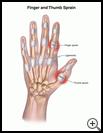
Finger Sprain
________________________________________________________________________
KEY POINTS
- A finger sprain is stretching or tearing of a ligament that connects one bone to another in the fingers.
- Change or stop doing the activities that cause pain until the sprain heals.
- A finger sprain can be treated with taping the finger, ice, exercise, and medicine.
________________________________________________________________________
What is a finger sprain?
A sprain is an injury to one or more of the ligaments in the finger. Ligaments are strong bands of tissue that connect one bone to another to form the joints. When a ligament is injured, it can be stretched, partially torn, or completely torn.
What is the cause?
A sprain is caused by an activity that twists or tears a ligament. This could happen, for example, when a ball hits the tip of your child’s finger or if your child falls onto a finger.
What are the symptoms?
Symptoms may include:
- Pain
- Swelling and bruising
- Trouble using or moving the finger
How is it diagnosed?
Your child’s healthcare provider will ask about your child’s symptoms, activities, and medical history and examine your child. Your child may have X-rays or other scans.
How is it treated?
Your child will need to change or stop doing the activities that cause pain until the ligament has healed.
Your child may need a finger splint or may need to have the injured finger taped to the finger next to it ("buddy taping") for several weeks after the injury.
Your child's healthcare provider may recommend stretching and strengthening exercises to help your child heal. In many cases, your child will be able to return to sports or activities if he or she wears a splint or has the fingers taped together.
The pain often gets better within a few weeks with self-care, but some injuries may take several months or longer to heal. It’s important to follow all your healthcare provider’s instructions.
How can I take care of my child?
To keep swelling down and help relieve pain for the first few days after the injury:
- Put an ice pack, gel pack, or package of frozen vegetables wrapped in a cloth on the injured area every 3 to 4 hours for up to 20 minutes at a time.
- Keep your child’s hand up on pillows so that it is above the level of the heart when he or she is sitting or lying down.
- Give your child nonprescription pain medicine, such as acetaminophen, ibuprofen, or naproxen. Read the label carefully and give your child the correct dose as directed.
- Nonsteroidal anti-inflammatory medicines (NSAIDs), such as ibuprofen, naproxen, and aspirin, may cause stomach bleeding and other problems. Check with your healthcare provider before you give any medicine that contains aspirin or salicylates to a child or teen. This includes medicines like baby aspirin, some cold medicines, and Pepto-Bismol. Children and teens who take aspirin are at risk for a serious illness called Reye’s syndrome.
- Acetaminophen may cause liver damage or other problems. Do not give more doses than directed. To make sure you don’t give your child too much, check other medicines your child takes to see if they also contain acetaminophen. Unless recommended by your healthcare provider, your child should not take this medicine for more than 5 days.
Your child should do the exercises recommended by your healthcare provider.
Follow your healthcare provider's instructions. Ask your provider:
- How and when you will get your test results
- How long it will take to recover
- If there are activities your child should avoid and when he or she can return to normal activities
- How to take care of your child at home
- What symptoms or problems you should watch for and what to do if your child has them
Make sure you know when your child should come back for a checkup. Keep all appointments for provider visits or tests.
How can finger sprains be prevented?
Make sure your child follows safety rules and uses any protective equipment recommended for his or her activities.
Last modified: 2019-07-19
Last reviewed: 2019-07-13

